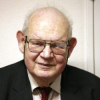Benoit Mandelbrot

Benoit Mandelbrot
Benoit B. Mandelbrot was a Polish-born, French and American mathematician with broad interests in the practical sciences, especially regarding what he labeled as "the art of roughness" of physical phenomena and "the uncontrolled element in life." He referred to himself as a "fractalist". He is recognized for his contribution to the field of fractal geometry, which included coining the word "fractal'", as well as developing a theory of "roughness and self-similarity" in nature...
NationalityFrench
ProfessionMathematician
Date of Birth20 November 1924
CountryFrance
I conceived and developed a new geometry of nature and implemented its use in a number of diverse fields. It describes many of the irregular and fragmented patterns around us, and leads to full-fledged theories, by identifying a family of shapes I call fractals.
I spent half my life, roughly speaking, doing the study of nature in many aspects and half of my life studying completely artificial shapes. And the two are extraordinarily close; in one way both are fractal.
Regular geometry, the geometry of Euclid, is concerned with shapes which are smooth, except perhaps for corners and lines, special lines which are singularities, but some shapes in nature are so complicated that they are equally complicated at the big scale and come closer and closer and they don't become any less complicated.
The theory of chaos and theory of fractals are separate, but have very strong intersections. That is one part of chaos theory is geometrically expressed by fractal shapes.
Everything is roughness, except for the circles. How many circles are there in nature? Very, very few. The straight lines. Very shapes are very, very smooth. But geometry had laid them aside because they were too complicated.
Self-similarity is a dull subject because you are used to very familiar shapes. But that is not the case. Now many shapes which are self-similar again, the same seen from close by and far away, and which are far from being straight or plane or solid.
If you look at a shape like a straight line, what's remarkable is that if you look at a straight line from close by, from far away, it is the same; it is a straight line.
There are very complex shapes which would be the same from close by and far away.
One of my conjectures was solved in six months, a second in five years, a third in 10. But the basic conjecture remains-the Mandelbrot Set.
Until a few years ago, the topics in my Ph.D. were unfashionable, but they are very popular today.
The techniques I developed for studying turbulence, like weather, also apply to the stock market
When the weather changes, nobody believes the laws of physics have changed. Similarly, I don't believe that when the stock market goes into terrible gyrations its rules have changed
I didn't want to become a pure mathematician, as a matter of fact, my uncle was one, so I knew what the pure mathematician was and I did not want to be a pure - I wanted to do something different.
The Mandelbrot set is the most complex mathematical object known to mankind.